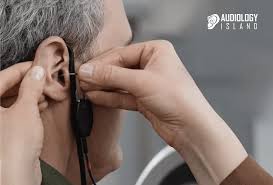How Audiologists Use Real Ear Measurement for Personalized Care

Hearing health is deeply personal, and every individual experiences hearing loss differently. That is why modern audiology goes beyond simply testing hearing thresholds. One of the most effective tools audiologists use today is Real Ear Measurement (REM). This technology allows for precise, personalized hearing care, ensuring that hearing aids and other devices are optimized for each patient’s unique needs.
What Is Real Ear Measurement?
Real Ear Measurement is a clinical procedure that measures the sound levels directly in a person’s ear canal. It involves placing a small microphone in the ear while the patient wears a hearing aid. The microphone measures how the hearing aid amplifies sound in real time, accounting for the unique shape and size of the ear canal.
Traditional hearing aid fitting methods rely heavily on averages or generic calculations, which may not accurately reflect the individual’s hearing profile. REM provides an objective, data-driven approach, allowing audiologists to tailor amplification to match the patient’s hearing loss precisely.
Why Real Ear Measurement Matters
Every ear canal is different. Factors such as the length, diameter, and curvature of the ear canal can significantly affect how sound reaches the eardrum. Without precise measurement, a hearing aid may over-amplify or under-amplify certain frequencies, reducing its effectiveness and comfort.
Real Ear Measurement ensures that the hearing aid delivers the correct amplification across all frequencies. This personalized adjustment improves clarity, reduces background noise, and enhances overall hearing performance. Patients experience more natural sound and better understanding in complex listening environments.
How Audiologists Perform Real Ear Measurement
The procedure for Real Ear Measurement is straightforward and non-invasive. The audiologist follows several steps:
- Placement of the Probe Microphone – A thin, flexible microphone is inserted gently into the ear canal, near the eardrum, without causing discomfort.
- Hearing Aid Programming – The hearing aid is turned on and programmed based on the patient’s hearing test results.
- Sound Measurement – The audiologist plays a series of sounds through a speaker or the hearing aid itself. The microphone captures how these sounds are modified within the ear canal.
- Real-Time Adjustments – Using software, the audiologist fine-tunes the hearing aid settings. The adjustments are based on the actual sound reaching the eardrum, not just theoretical calculations.
- Verification and Testing – After optimization, the audiologist confirms that the hearing aid provides the right amplification and clarity for the patient’s specific hearing profile.
Benefits of Real Ear Measurement
The use of Real Ear Measurement offers numerous advantages for patients and audiologists alike:
- Personalized Sound – Every patient receives amplification tailored to their unique ear canal and hearing loss profile.
- Improved Speech Understanding – Optimized settings help patients better understand speech, even in noisy environments.
- Enhanced Comfort – Properly calibrated hearing aids are more comfortable and natural sounding.
- Objective Verification – Audiologists have measurable, real-time data to support their adjustments and recommendations.
- Increased Patient Satisfaction – Patients often report higher satisfaction with their hearing aids when REM is used during fitting.
Who Can Benefit from Real Ear Measurement?
Real Ear Measurement is particularly useful for:
- New hearing aid users – Ensures the first fit is as accurate and comfortable as possible.
- Patients with complex hearing loss – Helps address varying amplification needs across frequencies.
- Children and older adults – Offers precise, safe fitting for sensitive ears.
- Patients experiencing hearing aid dissatisfaction – Identifies issues and fine-tunes performance for better results.
The Future of Personalized Hearing Care
As technology advances, Real Ear Measurement continues to evolve. Some audiologists combine REM with advanced software analytics, allowing for even more precise calibration and monitoring of hearing aid performance. Remote REM capabilities are also emerging, enabling adjustments and fine-tuning without requiring in-office visits.
This emphasis on personalization reflects a broader trend in audiology: moving from one-size-fits-all solutions to truly individualized care. By integrating Real Ear Measurement into their practice, audiologists ensure patients receive the best possible hearing experience.
Conclusion
Real Ear Measurement represents a major step forward in hearing care. By providing accurate, real-time data about how sound travels through the ear canal, audiologists can tailor hearing aids to each patient’s unique needs. This approach improves speech understanding, enhances comfort, and increases overall satisfaction with hearing devices.
For anyone experiencing hearing difficulties, consulting an audiologist who uses Real Ear Measurement can make a significant difference. Personalized care ensures that hearing aids work as effectively as possible, helping patients reconnect with the sounds of life and improve their overall quality of life.





